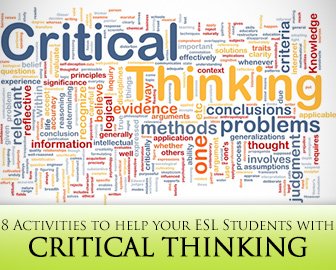Analyze This: How to Use Student Critical Analysis for Language Development in the ESL Classroom


This type of thinking, though, isn’t very complex. Recall and memorization only require surface level thinking. If you are teaching ESL to children, teaching critical thinking is particularly important because it will serve them in their futures no matter what language they are speaking. Teaching critical thinking, though, isn’t always easy. The following are some ways to integrate critical thinking exercises into your ESL lessons while still meeting the language goals you set for your students.

Sometimes an easy answer isn’t much of an answer at all. Getting your students to think about how they came to the answer that they did will challenge them to think critically, and it gets them using more language and using it in practical ways. For example, in an activity for using the simple future, you might ask your students what they will be doing in five years. One student might answer that he is going to be a movie star. You can ask questions like the following to get your student to think more critically: What makes you think that? What evidence do you see in your life now that will make that true in the future? By asking these questions, you challenge your student to think about his thinking. At the same time, you provide an opportunity for him to use English to express his ideas.
In classes like grammar, one answer to a question is usually the right one. But giving these types of answers often doesn’t require anything more than memorization and recall. When you can (and it might not be during a grammar lesson) ask questions that don’t have a “right” answer and challenge your students to think on a deeper level. For example, if you were doing a vocabulary unit on food, you might ask a recall question about what a waiter says when taking someone’s order. (What will you have?) An open ended question that will challenge your students to think more deeply might look like the following. If you were a server in a restaurant and worked the night shift, how would your life be different? How would you balance school and work? Encourage this type of thinking and expression and your students will benefit in more ways than one.
Part of your role in getting your students to think critically is giving them the time and the encouragement to do so. When you ask a question, giving your students a few minutes to think before they have to answer can mean the difference between a short easy answer and one that comes from serious thought. Doing this is easy. Simply count to sixty after asking a question to give your students a chance to think before they answer. You can also teach your students phrases like, “Can I have a minute to think…Give me just a minute” when they would like time to process their ideas. When they use these phrases, it tells you that they are actively trying to answer your question and gives them the space they need to put their ideas and words together before speaking. In addition, using this technique with native speakers will help those not familiar with ESL students know that your students are not unable to answer their questions but that they need a bit of time before they do.
For students of English as a second language, giving a quick answer is often appealing. A quick answer does the job and shows you can use language appropriately. However, a quick answer doesn’t necessarily encourage critical thinking. Using phrases to get your students to say (and think) more will help them use deeper thinking. You can say thinks like the following: Tell me more about that. What else do you think? Why is that good/bad/scary/difficult/or not? What part is most interesting to you? Why? Asking these questions challenges your students to say more.
When learning something new or tackling a new problem, all people sometimes need support. You can support your ESL students as they are learning new skills by giving them tools to help them. Giving examples, breaking tasks into smaller more manageable steps, giving hints or clues, and providing reminders can all help your students by giving them temporary supports in a new and challenging task. As your students become more adept at that task, remove these supports and encourage their successes, big and small. In the meantime, be patient and give them the assistance they need to reach success.
Encouraging argument doesn’t mean letting your students go for one another’s throats. Critical thinking means being able to make an argument for your beliefs or opinions. You can encourage your students to express logical and reasonable supports for their opinions during discussions and for writing assignments. Doing so will help them think analytically which is part of thinking critically. Have students give reasons or examples that support their ideas, and they will learn to support their arguments naturally.
Making predictions is a tool that is quite useful in the ESL classroom. You can ask your students to take a guess at what comes next in reading assignments (fiction, essays, informational articles) as well as video segments you play in class (movies, television shows, recorded dialogues). When they make these predictions, they not only have to think critically, they will be using the language skills they are learning. The next time your students are reading a passage or listening to a segment, hit pause and ask them what they think will come next.
Thinking about both sides of an argument will challenge your students to think beyond their own opinions and beliefs. A simple way to do this is to take a controversial statement and challenge your students to list some reasons in support of the statement as well as some reasons against it. Take the thinking a step further and teach your students how to make a refutation, either spoken or in writing, a skill that is often useful in the academic world.
After all, so much of language learning is rote memorization. But critical thinking can and does fit in the language classroom. Getting your students think more gets them saying more, and saying more is using language creatively and communicatively. Try one or more of these techniques with your students and see how well they can express their thoughts with the language they are learning.
How do you encourage your students to think critically?